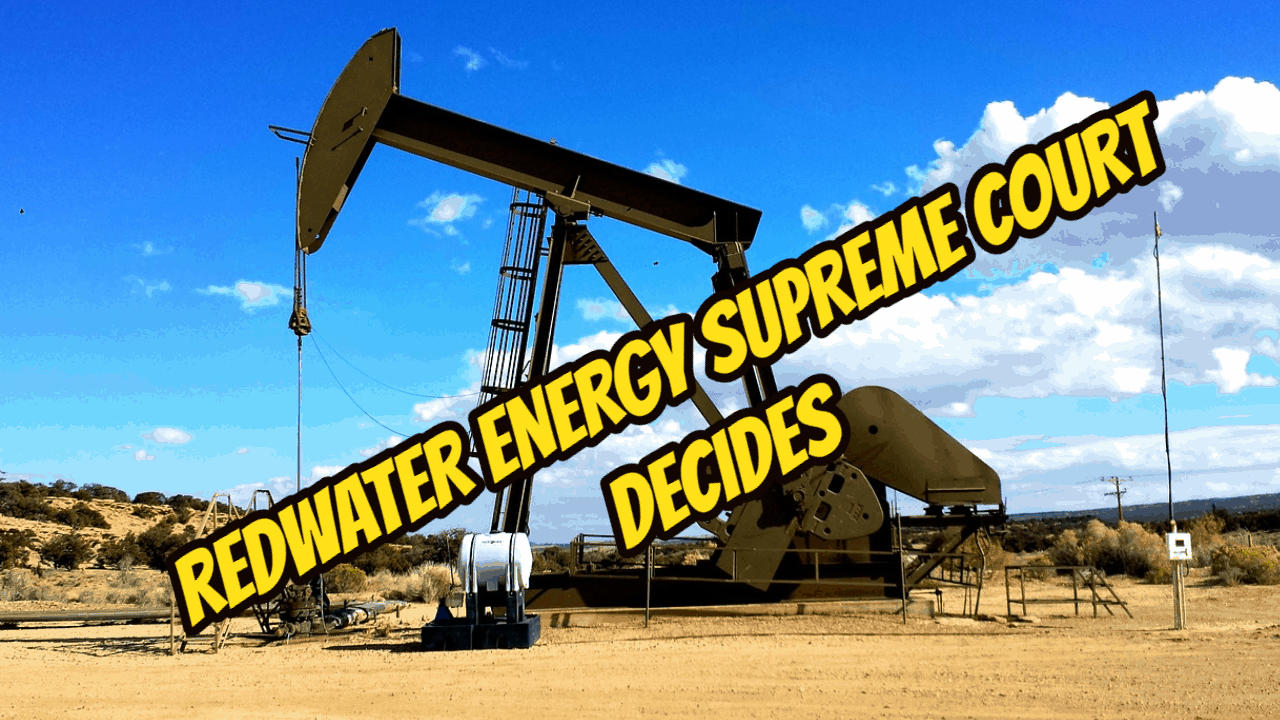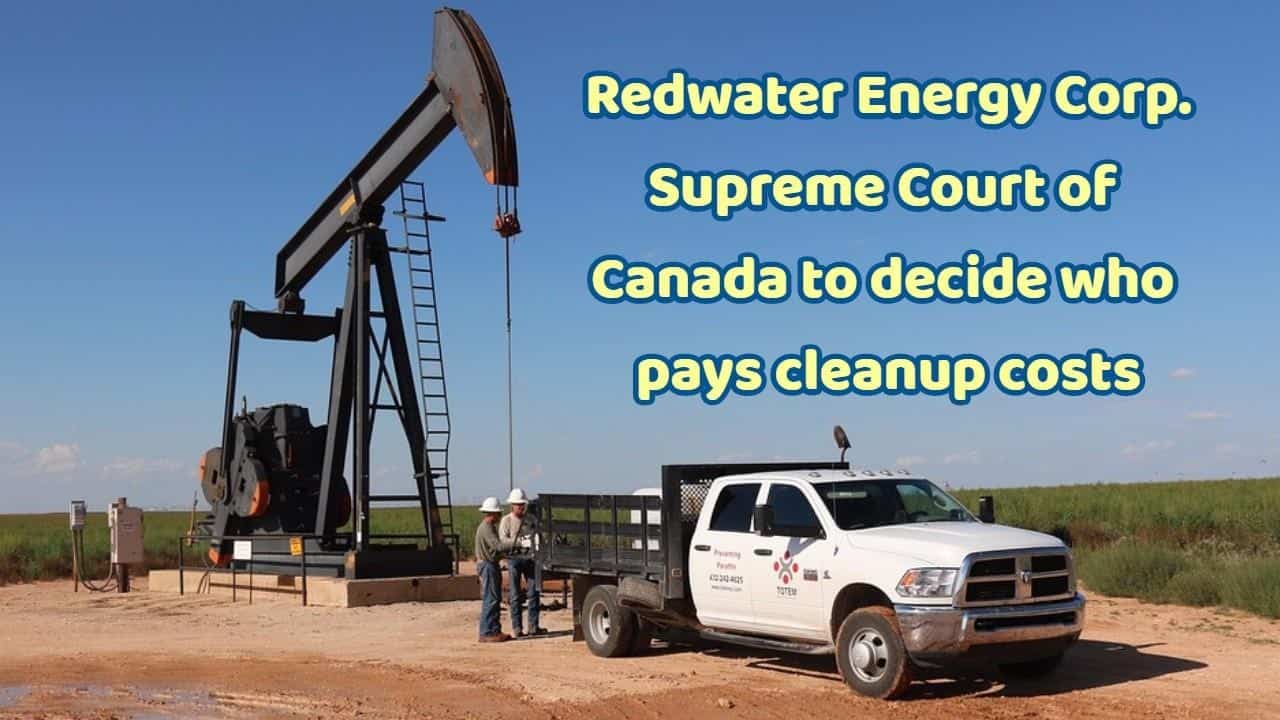
If you would prefer to listen to the audio version of this Redwater Energy Supreme Court Brandon’s Blog, please scroll to the bottom for the podcast.
Redwater Energy Supreme Court decision: Introduction
On January 31, 2019, the Redwater Energy Supreme Court decision was released. The 5-2 decision, in this case, Orphan Well Association v. Grant Thornton Ltd. overturned two Alberta lower Court decisions. It is now the law of the land that, before creditors receive any money, the receiver or trustee will have to spend the funds in its possession on reclamation or other environmental costs that provincial law may need.
The decision also made it clear that the receiver or trustee does not have to spend money it does not have. However, whatever money it recovers from the sale of assets, on a net basis, will first have to go to provincially mandated cleanup costs of the insolvent company’s property, before secured or unsecured creditors see a penny.
Redwater Energy Supreme Court decision: What the decision means
In my opinion, this is an important decision. Where provincial laws require companies to spend money to take certain steps when the business ceases, the assets of the company will be available to pay such costs.
Any company which is either a provincially regulated industry, or where provincial laws such as environmental laws have a real impact, will be affected. A Province will be able to insist that when a company ceases operating or is in receivership or bankruptcy, the company and its receiver or trustee, must use up to the full net realization from the sale of assets, to do what the provincial law requires, such as remediation of the real property.
This will no doubt affect how lenders view the value of their security and how much to lend to such companies. Property owners have now also been afforded some measure of protection against a commercial or industrial tenant’s activities and environmental transgressions.
Redwater Energy Supreme Court decision: Background
In my January 10, 2018 blog, REDWATER ENERGY CORP. – SUPREME COURT OF CANADA TO DECIDE WHO PAYS THE ENVIRONMENTAL CLEANUP COSTS OF THE BANKRUPTCY COMPANY, I described the 2-1 Alberta Court of Appeal decision upholding the Redwater ruling of the lower Court. The lower Court decision protected, in a bankruptcy, a lender’s secured priority over provincial ecological clean-up requirements.
Redwater Energy Supreme Court decision: The provincial environmental legislation
To work oil and gas sources in Alberta, a business requires a property interest in the oil or gas (commonly, a mineral lease with the Crown), rights and a licence issued by the Alberta Energy Regulator (Regulator). Under provincial regulation, the Regulator will certainly not provide a permit to remove, process or transport oil and gas in Alberta unless the licensee takes on end-of-life duties for plugging and capping oil wells to avoid leakages, taking apart surface area frameworks as well as restoring the surface area to its previous condition. These end-of-life responsibilities are called “abandonment” and “reclamation”.
The Licensee Liability Rating Program is one way the Regulator looks to guarantee the end-of-life commitments required of licensees. As a component of this program, the Regulator provides each business a Liability Management Rating (LMR), which is the proportion between the accumulated value assigned by the Regulator to a company’s assets under license and the accumulated liabilities determined by the Regulator to the last expense of abandoning and reclaiming those properties.
For determining the LMR, all the permits held by a business are dealt with as a bundle. A licensee’s LMR is determined monthly. Where it dips below the required ratio, the licensee is called upon to top up its LMR back up to the recommended level by paying a security deposit, executing the end-of-life responsibilities, or transferring permits with the Regulator’s authorization. If either the transferor or the transferee would have an LMR below 1.0 after such transfer, the Regulator will typically decline to authorize the permit transfer.
Redwater Energy Supreme Court decision: The insolvency of an oil and gas company
The insolvency of oil and gas firm licensed for operation in Alberta involves Alberta’s detailed licensing regime, which is binding on firms operating in the oil and gas market. The Bankruptcy and Insolvency Act (R.S.C., 1985, c. B-3) (BIA), is the federal government’s statute that controls the management of an insolvent’s estate and the organized and fair dealing of the insolvent’s property for the benefit of the unsecured creditors.
Alberta’s Environmental Protection and Enhancement Act (EPEA) makes certain that a licensee’s regulatory responsibilities will remain to be satisfied when it goes through bankruptcy by including the trustee of a licensee in the interpretation of the term “operator” for the goals of the obligation to reclaim and by ensuring that an order to execute reclamation work can be provided to a trustee.
Nevertheless, it specifically restricts a trustee’s responsibility about such an order to the value of the assets in the insolvent estate, other than for gross negligence or willful misconduct.
The Oil and Gas Conservation Act (OGCA) and the Pipeline Act take a more common method: they merely include trustees in the meaning of “licensee”. Therefore, every power which these Acts offer the Regulator versus a licensee can in theory additionally be worked out versus a trustee.
The Regulator has entrusted the authority to reclaim and abandon “orphans”– oil and gas properties and their sites left in an incorrectly deserted or unreclaimed state by inoperative companies at the close of their insolvency process– to the Orphan Well Association (OWA), an independent non-profit entity. The OWA has no power to look for compensation of its costs, however, it might be compensated up to the amount of any security deposit held by the Regulator to the credit of the licensee of the orphans once it has actually finished its environmental cleanup.
Redwater Energy Supreme Court decision: The Redwater receivership
Redwater, a publicly traded oil and gas firm, was initially given licenses by the Regulator in 2009. Its major assets were 127 oil and gas properties — wells, pipelines and related facilities — and their equal permits. A few of its licensed wells were still producing, yet the bulk was tapped out and strained with reclamation and abandonment obligations that surpassed their worth.
In 2013, ATB Financial, which had complete knowledge of the end-of-life responsibilities connected with Redwater’s properties, advanced funds to Redwater and, in return, was given a security interest in Redwater’s existing and after-acquired property. In mid-2014, Redwater started to experience financial problems.
ATB appointed its receiver in 2015. Back then, Redwater owed ATB roughly $5.1 million and had 84 wells, 7 facilities and 36 pipelines. Seventy-two were non-active or spent, however, considering that Redwater’s LMR did not go down below the recommended proportion until after it entered receivership, it never paid any type of security deposit to the Regulator.
Upon being informed of Redwater’s receivership, the Regulator advised the receiver that it was legitimately bound to fulfill Redwater’s abandonment commitments for all licensed properties before dispersing any funds or completing any insolvency proceeding. The Regulator cautioned that it would not accept the transfer of any one of Redwater’s licenses unless it was satisfied that both the transferee and the transferor would have the ability to carry out all governing responsibilities and that the transfer would not create deterioration in Redwater’s LMR.
The receiver determined that it could not satisfy the Regulator’s demands since the cost of completion of the end-of-life responsibilities for the spent wells would likely surpass the realizable value for the producing wells. Based upon this evaluation, the receiver notified the Regulator that it was occupying and controlling just 17 of Redwater’s most productive wells, 3 related facilities and 12 pipelines (Retained Assets). The receiver also advised that it was not occupying or controlling of any of Redwater’s various other licensed properties (Renounced Assets).
The receiver’s position was that it had no requirement to do any regulatory requirements connected with the Renounced Assets.
Redwater Energy Supreme Court decision: The Regulator’s and the receiver’s positions
The Regulator responded by issuing orders under the OGCA and the Pipeline Act calling for Redwater to suspend and abandon the Renounced Assets (Abandonment Orders). The Regulator imposed short target dates, as it took into consideration the Renounced Assets an environmental and safety threat.
Alberta’s Regulator and the OWA applied for an affirmation that the receiver’s renunciation of the Renounced Assets was void and for orders needing it to follow the Abandonment Orders and to carry out the completion of the end-of-life responsibilities connected with Redwater’s licensed properties. The Regulator did not look to hold the receiver responsible for these responsibilities past the assets in the Redwater estate.
The receiver brought a cross-application looking for authorization to seek a sales procedure leaving out the Renounced Assets and an order directing that the Regulator cannot stop the transfer of the licenses connected with the Retained Assets based upon, inter alia:
- the LMR requirements;
- failure to abide by the Abandonment Orders;
- refusal to take possession of the Renounced Assets; or
- Redwater’s outstanding debts to the Regulator.
A bankruptcy order was made against Redwater and the receiver was appointed as trustee. The trustee invoked s.14.06(4)(a)(ii) of the BIA about the Renounced Assets. This section of the BIA allows for the abandonment of a property and to not hold the trustee personally liable for remediation costs.
Redwater Energy Supreme Court decision: The Alberta decisions
The Alberta lower Courts concurred with the receiver and held that the Regulator’s suggested use its legal powers to impose Redwater’s conformity with reclamation and abandonment commitments in bankruptcy contravened the BIA in 2 ways:
- It required the receiver the commitments of a licensee in connection with the Redwater properties disclaimed by the receiver/trustee, contrary to s. 14.06(4) of the BIA.
- It ignored the priority for the distribution of a bankrupt’s assets under the BIA by requiring the provable claims of the Regulator, an unsecured creditor, be paid in advance of the claims of Redwater’s secured creditors. The dissenting Judge in the Court of Appeal would have permitted the Regulator’s appeal on the basis that there was no conflict between Alberta’s environmental laws and the BIA.
Redwater Energy Supreme Court decision: The Redwater Energy SCC decision
The majority 5-2 Supreme Court of Canada (SCC or the Supreme Court) decision states that:
- The Regulator’s use of its legal powers does not create a conflict with the BIA to trigger the doctrine of federal paramountcy.
- Section 14.06(4) of the BIA deals with the personal liability of trustees and does not let a trustee to walk away from the environmental liabilities of the estate it is administering.
- The Regulator is not asserting any claims provable in the bankruptcy.
- The priority scheme in the BIA is not being interfered with.
- No conflict is caused by the receiver’s status as a licensee under Alberta legislation. Alberta’s regulatory regime can coexist with and work with the BIA.
The Supreme Court decision goes on to say that bankruptcy is not a licence to ignore rules, and insolvency professionals are bound by and must follow valid provincial laws during bankruptcy.
They must, as an example:
- adhere to non-financial responsibilities that are binding on the insolvent estate, that are not provable claims; as well as
- the impacts of which do not contravene the BIA, regardless of the effects this might have for the insolvent’s secured creditors.
The SCC held that given the procedural nature of the BIA, the bankruptcy regimen counts greatly on the ongoing rules of provincial regulations. However, where there is an authentic problem between provincial statutes about property and civil liberties and bankruptcy regulations, the BIA dominates.
The SCC went on to say that the BIA has two main functions: (i) the fair distribution of the insolvent’s property among its creditors; and (ii) the insolvent’s financial rehabilitation. As Redwater is a company that will never arise from bankruptcy, just the first function matters.
The Abandonment Orders and the LMR demands are based upon legitimate provincial regulations of basic application — specifically, the type of legitimate provincial laws whereupon the BIA is constructed.
The Supreme Court of Canada decision found that there is no conflict between the Alberta regulatory scheme and s. 14.06 of the BIA, because, under s. 14.06(4), a trustee’s disclaimer of real property when there is an order to remedy any environmental condition or damage affecting that property protects the trustee from personal liability. The Supreme Court of Canada decision makes it very clear that although the BIA protects the trustee or receiver from personal liability, the ongoing liability of the bankrupt estate is unaffected.
The Supreme Court of Canada said that the end‑of‑life obligations binding on the trustee and receiver are not claims provable in the Redwater bankruptcy. Not all environmental obligations enforced by a regulator will be claims provable in bankruptcy.
The test that must be applied to decide whether a particular regulatory obligation amounts to a claim provable in bankruptcy is: (1) there must be a debt, a liability or an obligation to a creditor; (2) the debt, liability or obligation must be incurred before the debtor becomes bankrupt; and (3) it must be possible to attach a monetary value to the debt, liability or obligation. Only the first and third parts of the test are at issue in the Redwater case.
Bottom line, a court must decide whether there are enough facts indicating the existence of an environmental duty that will ripen into a financial liability owed to a regulator. In determining whether a non‑monetary regulatory obligation of a bankrupt is too remote or too speculative to be included in the bankruptcy proceeding, the court must apply the general rules that apply to future or contingent claims.
It must be sufficiently certain that the contingency will come to pass — in other words, that the regulator will enforce the obligation by performing the environmental work and seeking reimbursement.
The Supreme Court of Canada also went on to say that in crafting the priority scheme of the BIA, Parliament intended to permit regulators to place a first charge on real property of a bankrupt affected by an environmental condition or damage to fund remediation. Thus, the BIA explicitly contemplates that environmental regulators will extract value from the bankrupt’s real property if that property is affected by an environmental condition or damage.
Furthermore, Redwater’s only real assets were affected by environmental conditions or damage. Accordingly, the Abandonment Orders and LMR requirements did not seek to force Redwater to fulfill end‑of‑life obligations with assets unrelated to the environmental condition or damage. In other words, recognizing that the Abandonment Orders and LMR requirements are not provable claims and do not interfere with the aims of the BIA — rather, it facilitates them.
Redwater Energy Supreme Court decision: What about your company or client?
Is your company subject to significant costs under provincial law should it stop operating for any reason, including receivership or bankruptcy? Are you a secured creditor who loaned money to such a company and are now questioning the value of your security?
If so, you need the help of a licensed insolvency trustee (formerly called a bankruptcy trustee). Call the Ira Smith Team today. We have decades and generations of experience in the restructuring, turnaround, monitoring and liquidating insolvent companies.
Contact the Ira Smith Team today for your free consultation so that we can solve your financial problems and get you back on the right path, Starting Over Starting Now.
[monkeytools msnip=”http://monkeyplayr.com/playr.php?u=5173&p=20169″]



